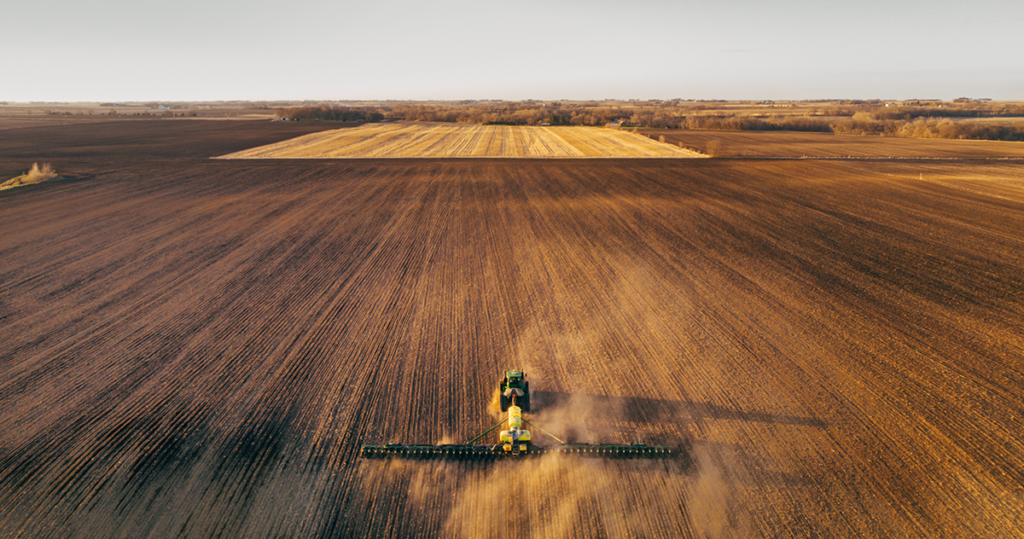Pivot Bio’s Early Season Agronomic Outlook

We spoke with Pivot Bio Agronomists across the country to understand what impact the winter months had on the outlook for the 2025 crop season. Hear from our team members in Illinois, Iowa, North Dakota, the Carolinas, and Ohio on where the season stands in early April.
Marc Cartwright – North Dakota
The winter season in North Dakota was a continuation of the summer and fall weather – with sporadic moisture events. It seemed like the further north parts of North Dakota saw the more consistent snow accumulation and snow cover.
Here in the Grand Forks area, the snowfall has been below average for the winter season, which is a continuation of an overall dry spell in past 6-8 months. However, heavy snow at the end of March did have us gain significant moisture.
Although dry fall conditions did not allow some fertility applications back in October and November, there should be enough soil moisture now to allow spring fertility and planting in good conditions. Folks will be planting spring wheat, corn, soybeans, and sugar beets from the start. Looking at the extended forecast, I’d say the regions farmers will be optimistic to get rolling by the end of April.
A few of the meteorologists who specialize in longer range forecasting have discussed the outlook of a drier summer, preceded by some good moisture events in the spring. I assume once we get into a drier pattern in North Dakota and Minnesota we’ll once again have scattered showers and spotty rain patterns – it will be the luck of the draw across the area.
I always share in the farmers excitement to get the spring under way. It’s always a nice and busy time of year where farms can focus on performing in many different facets. I continue to be optimistic – we’re in the breadbasket of the upper Midwest (Red River Valley region), so even though the forecast might look like a drier season, the yield potential can still be strong with our rich soils, and may even increase a tad with less water to manage across some fields.
Ryan Collett – Ohio
This winter, throughout the state of Ohio, we had a stretch of some very cold temperatures. I feel like we don’t have the harsh winters near as much, and if we do, it’s only for a short period of time. However, this year we had an extended period of cold temperatures and a lot of snow late in the winter, which can be really good for killing off pests and insects in the soil.
We’ve had a ton of excess rain so things have been delayed for Ohio. Every year, farmers are always pushing the needle to get things started earlier and earlier. If the conditions are fit, that’s always going to be the case. We had a lot of beans planted in early April last year, right around this time. At the moment I only know a couple of operations that have beans in the ground. Other spring work aside from planting like tillage and anhydrous have been delayed as well.
For us at Pivot Bio, we always want to emphasize good stewardship of our product. The nice thing about our microbes is they prefer the cooler conditions, so even though it may be cooler outside, if the ground conditions and soil temperatures are adequate, we will still be safe. What’s been great with our product is we have done extensive testing to ensure we are getting great germination and even emergence with our on-seed products, as well as liquid in furrow.
Kalleigh Goodson – Southeast Iowa
From a precipitation standpoint, Southeast Iowa was on the lower side over the course of the winter months. We had two snowstorms that were significant, bringing more than just an inch or so of precipitation. I keep up with Green Cast, a soil moisture monitoring system, as well as the ISU Soil Temperature map. We were trending quite a bit lower as far as soil moisture off the 5-year and 10-year average for this part of the state, so it will be interesting to see what effects this has on the crop season.
In terms of when planting will start, in looking at the 14-day forecast and with where we are sitting with precipitation, we should be ready to go in time. I don’t anticipate any delays, at least from weather events.
In my little portion of the state, if we start out dry, it’s somewhat concerning for the remainder of the season. The ground is a bit rougher down here and not quite as forgiving as we move a little further north into the territory. I want to speak broadly because a lot can change in the month of April, which tends to be when we catch up on some of that needed precipitation. Regardless of whether we’re going to be too wet or dry, I like to say to growers that Pivot Bio’s products that additional protection into a nitrogen program.
As far as outlook, at this point in the season it’s hard not to be optimistic. Once the sun starts shining, everybody is getting everything ready, and we start seeing planters come out of the shed, it’s great reassurance that we are going to get set up well for a successful season.
Jay Long – Northern Illinois
We had very little snow this winter in Northern Illinois – you could say low amounts of snow for the region. Temperature wise, it felt like a short winter. There was a two-week cold snap where we experienced negative temperatures, but otherwise we were oddly warm.
Although temperatures above ground were higher, the soil is still waking up. If you look at the month-long forecast projection for Northern Illinois, the temperatures are having a warming tread, but the lows are still concerning. We’ll need to wait until the soil temperature reaches an adequate temperature to plant corn. It is a typical spring in Northern Illinois as of now.
The one call-out I have is to remind everyone to stay safe. Over the next few weeks there is going to be a lot of anhydrous ammonia tanks, implements, and farmers on the roadways. Please be mindful of them and slow down!
If the weather stays right, I think we are looking at a good crop this season. Around the countryside there has been a lot of anhydrous ammonia put on in the last few weeks. Farmers in my area are capitalizing on the dry, warm weather we’ve had in March to get some early fieldwork done. April looks a little wet, but you know what they say, “April showers bring May flowers.” Overall, I feel that 2025 is going to be a fantastic growing season and I cannot wait to see the planters in the fields.
Makala Pittman – North Carolina, South Carolina, Virginia
We experienced an extremely dry summer last year, which placed us on the drought monitor for the season. We did receive a couple of tropical storms in the fall, but since mid-October, we have only had 7 or 8 inches of total precipitation, so it’s been a dry winter, putting us in a similar pattern to where we were last year.
We’re having a pretty average spring – it’s been really warm the past 2-3 weeks, so we are right where we need to be for planting. In South Carolina, they started planting at the end of March, so we will work our way north from there. North Carolina will be starting this week, then Virginia will follow around mid April into May. Cotton will also be later in April and May since we want the soil temperature to be a little warmer and nightly temps to be warm as well.
We are still considered to be in a drought in many parts of North Carolina, which is an interesting way to start the season. Once we get later into April, we are hopeful we will start getting some of those spring pop up showers. Our water tables are still low, so we really need those rain events to bring those back up to get us through the summer.
I have been encouraging growers this year to consider spreading their risk out when it comes to planting dates. You don’t always have the be the first person to start planting or the first to finish. Making sure you have appropriate varieties for your area and planting a range of early to late hybrids can help spread your risk. It’s all about not putting all your eggs into one basket. Also, just because we experienced drought last year, doesn’t mean we will continue those same patterns this season. We never know what the weather will bring, so we need to make our most informed decisions now and hope they pay off in the long run.
Even though last year was tough in our region, we are holding on to the hope that we don’t get back-to-back drought years. In looking at the weather patterns over the last decade, we typically do not see two “bad” drought years in a row. So that gives us some hope as well. There have been seasons in the past where a wet February and March kept us out of the field and we got behind on prepping land and planting. Luckily, we haven’t had to overcome those hurdles this year. I’m very optimistic about this growing season and the potential to make a great crop.


